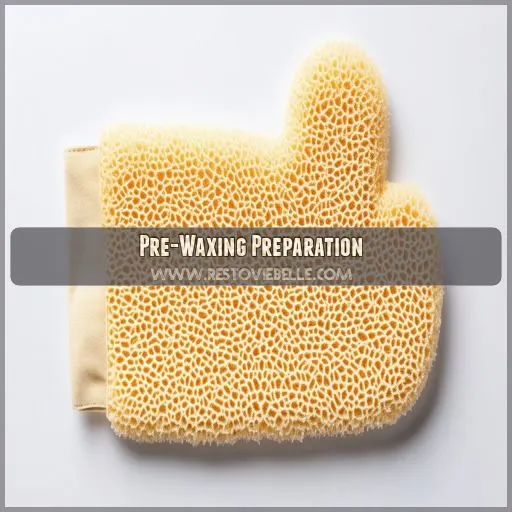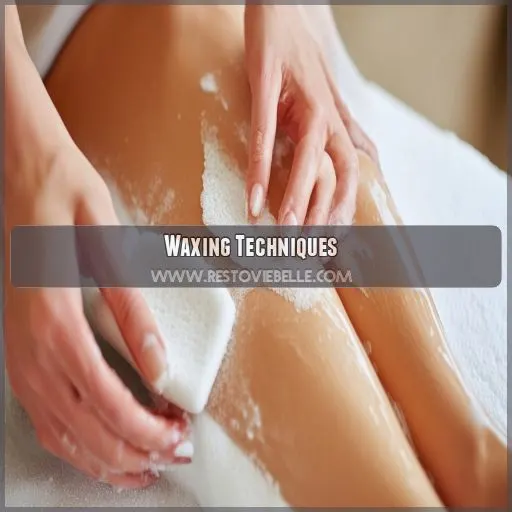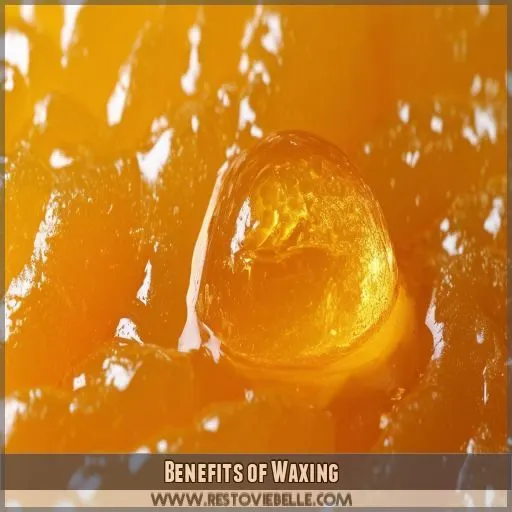This site is supported by our readers. We may earn a commission, at no cost to you, if you purchase through links.

Learning how to wax your legs at home will save time and money and give you control over your grooming routine.
This step-by-step guide covers all the processes involved, from pre-waxing preparation to essential techniques, to have both smooth and hair-free legs.
Acquire knowledge and eventually the confidence to achieve professional results in the comfort of your own home.
Table Of Contents
- Key Takeaways
- How to Wax Your Legs at Home?
- Pre-Waxing Preparation
- Waxing Techniques
- Waxing Essentials
- Common Mistakes to Avoid
- Benefits of Waxing
- Additional Tips and Considerations
- Frequently Asked Questions (FAQs)
- Can you wax your legs by yourself?
- Is it worth it to wax your legs at home?
- Do you wax your legs before or after a shower?
- How do you clean your legs before waxing?
- Does waxing remove leg hair?
- How do I Wax my Legs at home?
- Can You wax your legs?
- How long does it take to wax your legs?
- How to manage waxing pain during the process?
- Can pregnant women safely wax their legs?
- What age is appropriate to start waxing?
- How to handle waxing with sensitive skin?
- Is it safe to wax varicose veins?
- Conclusion
Key Takeaways
- Discover the secrets to salon-quality leg waxing at home, saving you time and money.
- Learn how to choose the right wax for your skin type and apply it like a pro.
- Say goodbye to the pain and hello to smooth, hair-free legs by following the expert techniques.
- Embrace the power of waxing, leaving you with longer-lasting results and thinner hair regrowth.
How to Wax Your Legs at Home?
To wax your legs at home, start by choosing a wax that suits your skin type and ensuring your leg hair is between 1/4 to 1/2 inch long.
Exfoliate your skin 24 hours before and test a small area for sensitivity.
Clean your skin thoroughly before waxing. Apply the wax in the direction of hair growth and pull the strips parallel to your skin for minimal pain. Keep the skin taut to reduce discomfort.
After waxing, moisturize to prevent irritation. Avoid common mistakes like waxing over irritated skin or using insufficient hair length.
Follow these steps for smooth, long-lasting results. Discover extra tips and tricks next.
Pre-Waxing Preparation
First, select a wax formula for your skin type for safety and efficacy. Be sure you have exfoliated your skin and allowed the leg hair to grow to a 1/4 and 1/2 inch long; otherwise, waxing won’t work correctly.
Choosing the Right Wax Formula
The right wax formula is essential in successful home waxing. Consider:
- Sensitive Skin: Ensure the use of hypo-allergenic formulas.
- Durations of hairs: Soft wax for large areas, hard wax for small ones: for longer hair, soft wax; for shorter hair, hard wax.
- First-timers: Pre-loaded strips make it easy to apply.
- Waxing kits: Make sure they’re supplied with all the necessary materials/elements.
Preparing Your Skin
First, exfoliate your legs 24 hours before waxing to help release as many dead skin cells as possible. Treat with gentle, almost destructible DIY alternatives like sugar scrubs. Test your skin’s sensitivity and have first-aid supplies near you. Clean the skin well before applying wax for it to work effectively.
| Task | Tools/Methods | Reason |
|---|---|---|
| Exfoliate | Sugar scrubs | For removing dead skin cells |
| Sensitization Check | Anti-redness cream, prevent reaction | |
| Prepare Supplies | First-aid kit | In case of emergencies |
| Clean Skin | Mild Soap and Water | Wax adheres better |
Ensuring Proper Hair Length
Your hair should be 1/4 to 1/2 an inch long for easy leg waxing. The length of the hair at this measurement is enough for the wax to have a good grip on it; hence, it removes hairs efficiently. On the other hand, growth that’s too short will prevent the sticking of the wax, thus complicating the process.
Waxing Techniques
For a successful leg waxing, start by applying wax in the direction of hair growth. Swiftly pull the strips off parallel to your skin for the best results.
Applying Wax Correctly
The wax should be warm, not hot. Apply a thin layer of resin-based or strip wax in a direction along the hair growth. Press firmly. Use a thicker layer for hard wax. Check the thickness and the technique, which is essential for good home waxing.
Removing Wax Strips Efficiently
This is good for pulling out the wax strips efficiently, reducing much of the pain by holding your skin tight.
Now, quickly pull the strip parallel to your skin—not upwards. Ensure that you have the right wax consistency and that the technique is correct.
If you’re one with sensitive skin, then use some azulene oil.
High-quality strips are enormous for their smooth finishing.
Tips for Smooth Removal
The wax should be at room temperature or a bit warm, with a smooth consistency—not too thick.
If the skin is well hydrated before applying the wax, it will make the wax adhere.
Press down on the strip firmly and remove quickly, parallel to the skin.
For pain management, breathe out as you pull.
Follow with post-wax skincare like aloe vera or moisturizer.
Waxing Essentials
You will need professional materials to ensure everything goes smoothly, up to its effective potential: a recommended waxing kit and strips. Focus on post-wax care for soft, irritation-free skin after waxing.
Essential Materials
To wax your legs at home, you’ll need a few essential materials. First, get the right wax formula for your skin type. Then, have extra waxing strips handy. Finally, store your materials in a clean, dry place for future use.
- Wax formula
- Waxing strips
- Storage containers
Waxing Kits and Strips
Waxing kits do make things easier, especially for the first part. Pre-loaded strips are available if you want it very easily, or you can get liquid wax if you need to be more precise. Always double-check the ingredients in wax for safety. Try out different kits until you find one that’s just right for you and your hair/skin type.
Post-Waxing Care
Moisturize your legs to some degree after waxing, which can help prevent dry skin. Continue exfoliating so that ingrown hairs never arise. Apply ice or aloe vera for brows lifted in irritation. Now revel in smoother skin, but remember, it usually only lasts about a month.
Common Mistakes to Avoid
Avoid the common mistakes of waxing, such as putting wax on irritated skin or stripping incorrectly. Be sure to have hair of the proper length, stay moisturized and exfoliated and maintain techniques against ingrown hairs and irritated skin.
Waxing Over Irritated Skin
Never wax over irritated skin.
- Increases post-waxing irritation
- Can lead to allergic reactions
- Causes more pain and discomfort
- Exacerbates skin sensitivity
- Avoids sun exposurerelated burns
Incorrect Wax Removal
Incorrect strip application, excessive strip removal angle, and peeling strip too slowly can cause ineffective hair removal. Always pull swiftly and parallel.
Insufficient Hair Length
Ensuring your leg hair is 1/4 to 1/2 inch long helps prevent follicle damage, manage pain, and minimizes the risk of ingrowns.
Moisturizing and Exfoliating
After waxing, moisturizing and exfoliating properly can prevent irritation, minimize dryness, and soothe itchiness:
- Use fragrance-free lotion
- Avoid harsh chemicals
- Apply aloe vera
- Exfoliate gently
Preventing Ingrown Hairs
To prevent ingrown hairs, exfoliate regularly, consider methods like sugar paste, tweezing, epilator, laser treatment, or electrolysis, and moisturize your skin.
Managing Skin Irritation
It is important to take care of irritated skin. Here’s how:
- Cold compress to reduce redness.
- Apply aloe vera to your skin for soothing.
- Moisturize to reduce inflammation.
- Don’t use perfume to prevent itching.
Benefits of Waxing
Waxing offers you smoother skin for an extended period compared to shaving, making it a favorite for those seeking long-lasting results. Additionally, you’ll notice your hair tends to grow back thinner over time, providing you with a more comfortable regrowth experience.
Smoother Skin for Longer
You are waxing leaves your skin smoother for a more extended period since it removes the hair from the root and, hence, takes a long to regrow. If you happen to have conditions like diabetes, or you’re using Accutane, undergoing chemotherapy, or you’re on steroids, then it’s necessary to consult a professional to ensure safety.
Thinner Hair Regrowth
You’ll also notice that waxing weakens hair follicles over time, leading to thinner regrowth. This is beneficial for various reasons:
- Less noticeable hair
- Easier and less frequent waxing sessions
- Smoother texture
- Reduced skin sensitivity
Personal Preference
Waxing’s a personal choice, but it offers the advantage of smoother, longer-lasting skin. For those with waxing allergies or skin sensitivities, consider home remedies and beginner tips. Address post-waxing bumps with proper care to keep your skin flawless and irritation-free.
Additional Tips and Considerations
You have to consider skin types and sensitivities when waxing at home, and if you’re unsure or have any health complications, consult a professional or your doctor; taking some pain relievers ahead can also help make it more comfortable.
Consulting Professionals
If you’re taking medications such as steroids or Accutane, it’s essential to seek out a professional since these medications will increase waxing risks. Also, discuss any allergies and ensure safety measures against any bad reactions. Professionals have experience; thus, it’s much smoother and safer.
Waxing for Specific Skin Types
For sensitive skin, use hypoallergenic wax and aloe vera post-wax. If you have dry skin, moisturize well before and after. For oily skin, cleanse thoroughly before waxing. Combination skin requires balanced care, and mature skin benefits from gentler wax formulas.
Managing Pain and Discomfort
To manage pain and discomfort during waxing, consider these tips:
- Pain management: Take a pain reliever an hour before waxing.
- Discomfort reduction: Use a cold compress afterwards.
- Numbing methods: Apply numbing cream beforehand.
- Relaxation techniques: Practice deep breathing to stay calm.
Frequently Asked Questions (FAQs)
Can you wax your legs by yourself?
Yes, you can wax your legs yourself. Be sure that the length of your hair is from 1/4 to 1/2 an inch long, then use the suitable wax and apply proper techniques to get smooth results. It does get easier after some practice.
Is it worth it to wax your legs at home?
You can spare your pocket and save time by waxing your legs at home. Moreover, with practice, you’ll find the process more straightforward and the results smoother and more long-lasting than shaving. Just be sure to follow proper pre and post-care routines.
Do you wax your legs before or after a shower?
Waxing of legs should be performed immediately after a shower when the skin is clean and some of the subcutaneous fat has been softened by warm water. Be sure to dry your skin well before applying the wax for best results.
How do you clean your legs before waxing?
Exfoliate your legs with some warm water and mild soap before waxing. Make sure to rinse very well to remove all residues. Dry yourself completely; this is because moisture can prevent the wax from sticking properly to the skin.
Does waxing remove leg hair?
Absolutely, waxing removes leg hair by pulling it out from the root. This leaves your legs smoother for longer compared to shaving. Just follow the right steps, and you’ll feel the difference under your fingertips.
How do I Wax my Legs at home?
Best interjections can be to exfoliate a day before, apply wax in the hair growth direction, press strips firmly, and pull swiftly against hair growth. Moisturize after, and use aloe vera if irritation occurs. Aim for practice.
Can You wax your legs?
Almost 77 percent of women go for waxing for smooth and smooth legs, unlike shaving. Yes, you can wax your legs by choosing the suitable wax, preparing adequately, and following precise steps. More practice means better results and longer-lasting smoothness.
How long does it take to wax your legs?
Waxing your legs at home typically takes about 30 to 45 minutes. Make sure to allocate extra time for preparation and aftercare, especially if you’re a beginner. Practice will help you get quicker and more efficient.
How to manage waxing pain during the process?
Interestingly, a good 80% of people find pain manageable when they take ibuprofen an hour before waxing. Exfoliate a day before, apply firm pressure after removing the strips to soothe possible discomfort, and have a numbing cream if you need more.
Can pregnant women safely wax their legs?
Yes, pregnant women can safely wax their legs, but their skin might be more sensitive. It’s wise to test a small area first and consult a healthcare provider for any concerns. Avoid waxing if experiencing severe skin changes.
What age is appropriate to start waxing?
Generally, girls in this age group may start waxing around 13-15 years, depending on their comfort level, parents’ consent, and proper techniques to carry out waxing. Good skincare is introduced before commencing any course of wax treatment.
How to handle waxing with sensitive skin?
Handle sensitive skin by choosing a gentle wax, exfoliating 48 hours prior, and moisturizing well. Apply aloe vera post-waxing to soothe irritation. Avoid retinoids or strong acne medications before waxing to prevent adverse reactions.
Is it safe to wax varicose veins?
Tread lightly around waxing varicose veins. Just as you wouldn’t storm a fragile bridge, avoid applying wax over these areas due to increased sensitivity and risk of damage. Instead, consult your physician for safer hair removal options.
Conclusion
Imagine effortlessly achieving salon-like results at home. By mastering how to wax your legs at home, you’ll gain smoother skin, longer-lasting results, and control over your grooming routine.
Follow the step-by-step guide carefully, from preparation to post-waxing care, and avoid common mistakes. Use the right techniques and materials to achieve professional outcomes.
Embrace the benefits of waxing, and consider the additional tips for managing discomfort and consulting professionals when needed. Enjoy your journey to smoother, hair-free legs.












